Applying Assertive Communication in Nursing: Benefits and Limitations
VerifiedAdded on 2023/04/04
|8
|1915
|309
Essay
AI Summary
This essay explores the critical role of assertive communication in nursing, emphasizing its importance in various healthcare interactions. It contrasts traditional submissive nursing communication with the benefits of assertiveness, which involves expressing oneself directly and honestly while respecting others' rights. The essay discusses models for practicing assertive communication, such as the "See it, Say it, Fix it" and the five-step model, using a hypothetical scenario where a nurse interacts with an aggressive family. It highlights the necessity of assertive communication in maintaining professional boundaries, ensuring clear and honest information sharing, and fostering trust. The essay also addresses common barriers to assertiveness among nurses and advocates for incorporating assertive communication skills into nursing education to enhance professional confidence and improve patient care.
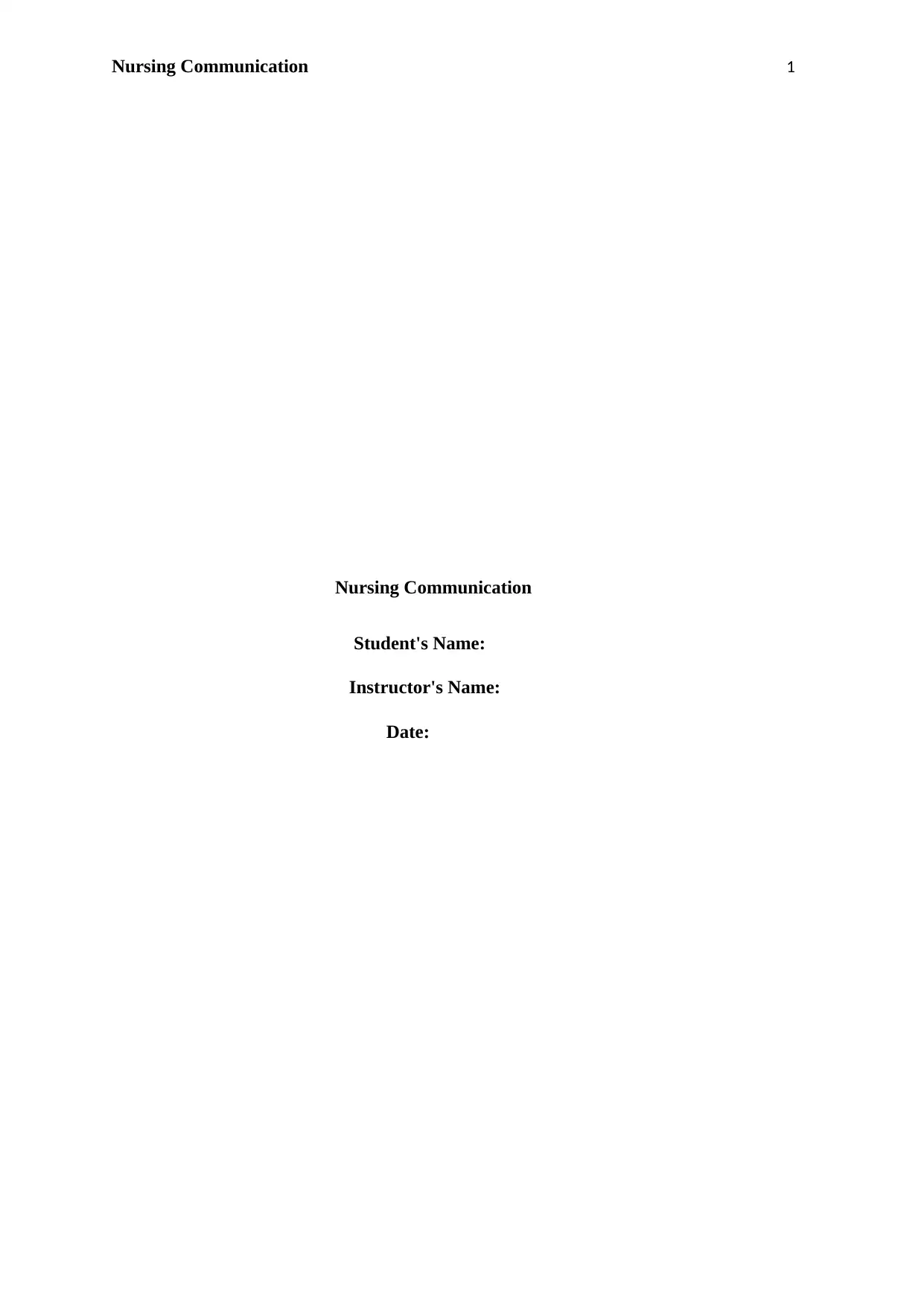
Nursing Communication 1
Nursing Communication
Student's Name:
Instructor's Name:
Date:
Nursing Communication
Student's Name:
Instructor's Name:
Date:
Paraphrase This Document
Need a fresh take? Get an instant paraphrase of this document with our AI Paraphraser
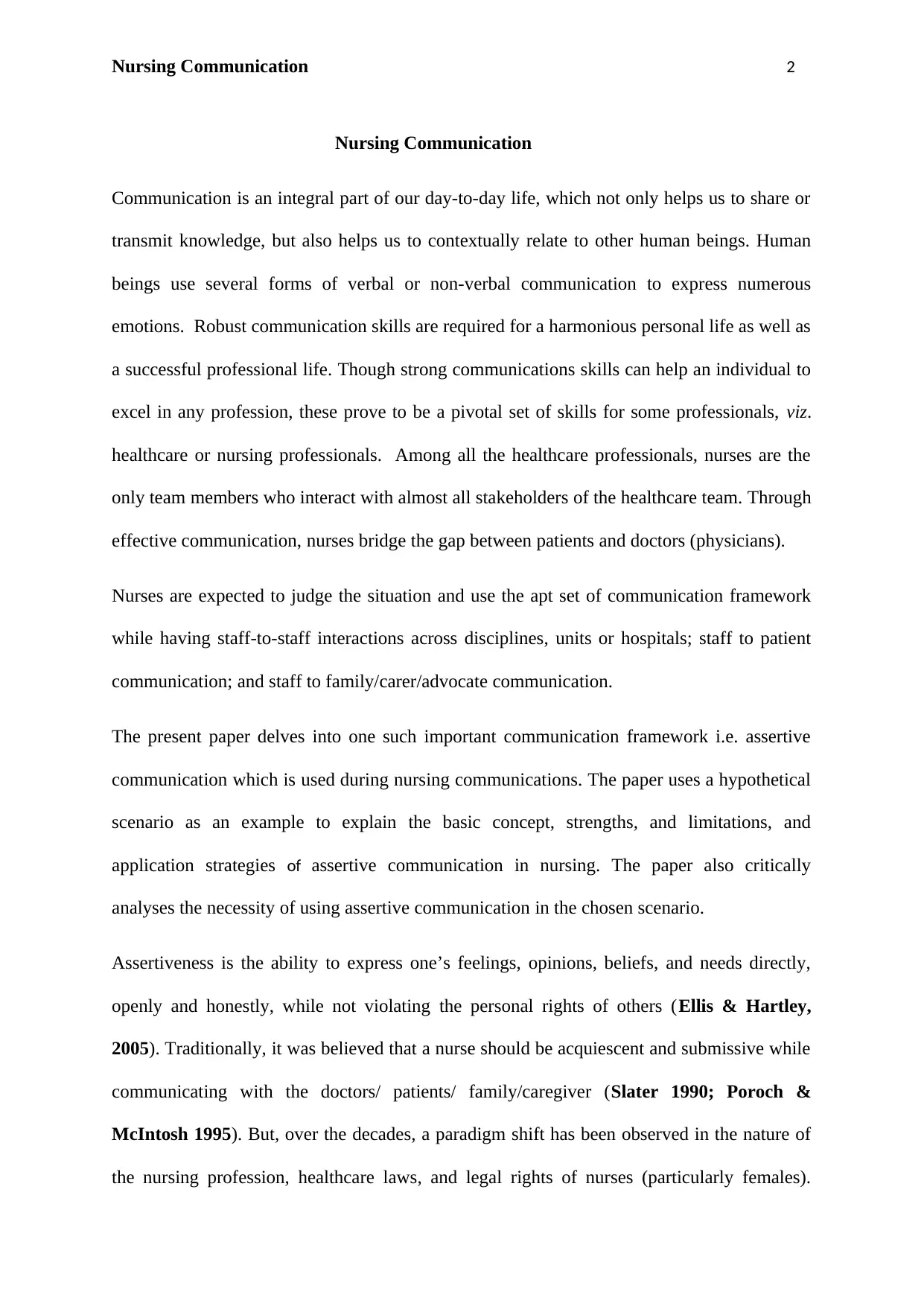
Nursing Communication 2
Nursing Communication
Communication is an integral part of our day-to-day life, which not only helps us to share or
transmit knowledge, but also helps us to contextually relate to other human beings. Human
beings use several forms of verbal or non-verbal communication to express numerous
emotions. Robust communication skills are required for a harmonious personal life as well as
a successful professional life. Though strong communications skills can help an individual to
excel in any profession, these prove to be a pivotal set of skills for some professionals, viz.
healthcare or nursing professionals. Among all the healthcare professionals, nurses are the
only team members who interact with almost all stakeholders of the healthcare team. Through
effective communication, nurses bridge the gap between patients and doctors (physicians).
Nurses are expected to judge the situation and use the apt set of communication framework
while having staff-to-staff interactions across disciplines, units or hospitals; staff to patient
communication; and staff to family/carer/advocate communication.
The present paper delves into one such important communication framework i.e. assertive
communication which is used during nursing communications. The paper uses a hypothetical
scenario as an example to explain the basic concept, strengths, and limitations, and
application strategies of assertive communication in nursing. The paper also critically
analyses the necessity of using assertive communication in the chosen scenario.
Assertiveness is the ability to express one’s feelings, opinions, beliefs, and needs directly,
openly and honestly, while not violating the personal rights of others (Ellis & Hartley,
2005). Traditionally, it was believed that a nurse should be acquiescent and submissive while
communicating with the doctors/ patients/ family/caregiver (Slater 1990; Poroch &
McIntosh 1995). But, over the decades, a paradigm shift has been observed in the nature of
the nursing profession, healthcare laws, and legal rights of nurses (particularly females).
Nursing Communication
Communication is an integral part of our day-to-day life, which not only helps us to share or
transmit knowledge, but also helps us to contextually relate to other human beings. Human
beings use several forms of verbal or non-verbal communication to express numerous
emotions. Robust communication skills are required for a harmonious personal life as well as
a successful professional life. Though strong communications skills can help an individual to
excel in any profession, these prove to be a pivotal set of skills for some professionals, viz.
healthcare or nursing professionals. Among all the healthcare professionals, nurses are the
only team members who interact with almost all stakeholders of the healthcare team. Through
effective communication, nurses bridge the gap between patients and doctors (physicians).
Nurses are expected to judge the situation and use the apt set of communication framework
while having staff-to-staff interactions across disciplines, units or hospitals; staff to patient
communication; and staff to family/carer/advocate communication.
The present paper delves into one such important communication framework i.e. assertive
communication which is used during nursing communications. The paper uses a hypothetical
scenario as an example to explain the basic concept, strengths, and limitations, and
application strategies of assertive communication in nursing. The paper also critically
analyses the necessity of using assertive communication in the chosen scenario.
Assertiveness is the ability to express one’s feelings, opinions, beliefs, and needs directly,
openly and honestly, while not violating the personal rights of others (Ellis & Hartley,
2005). Traditionally, it was believed that a nurse should be acquiescent and submissive while
communicating with the doctors/ patients/ family/caregiver (Slater 1990; Poroch &
McIntosh 1995). But, over the decades, a paradigm shift has been observed in the nature of
the nursing profession, healthcare laws, and legal rights of nurses (particularly females).
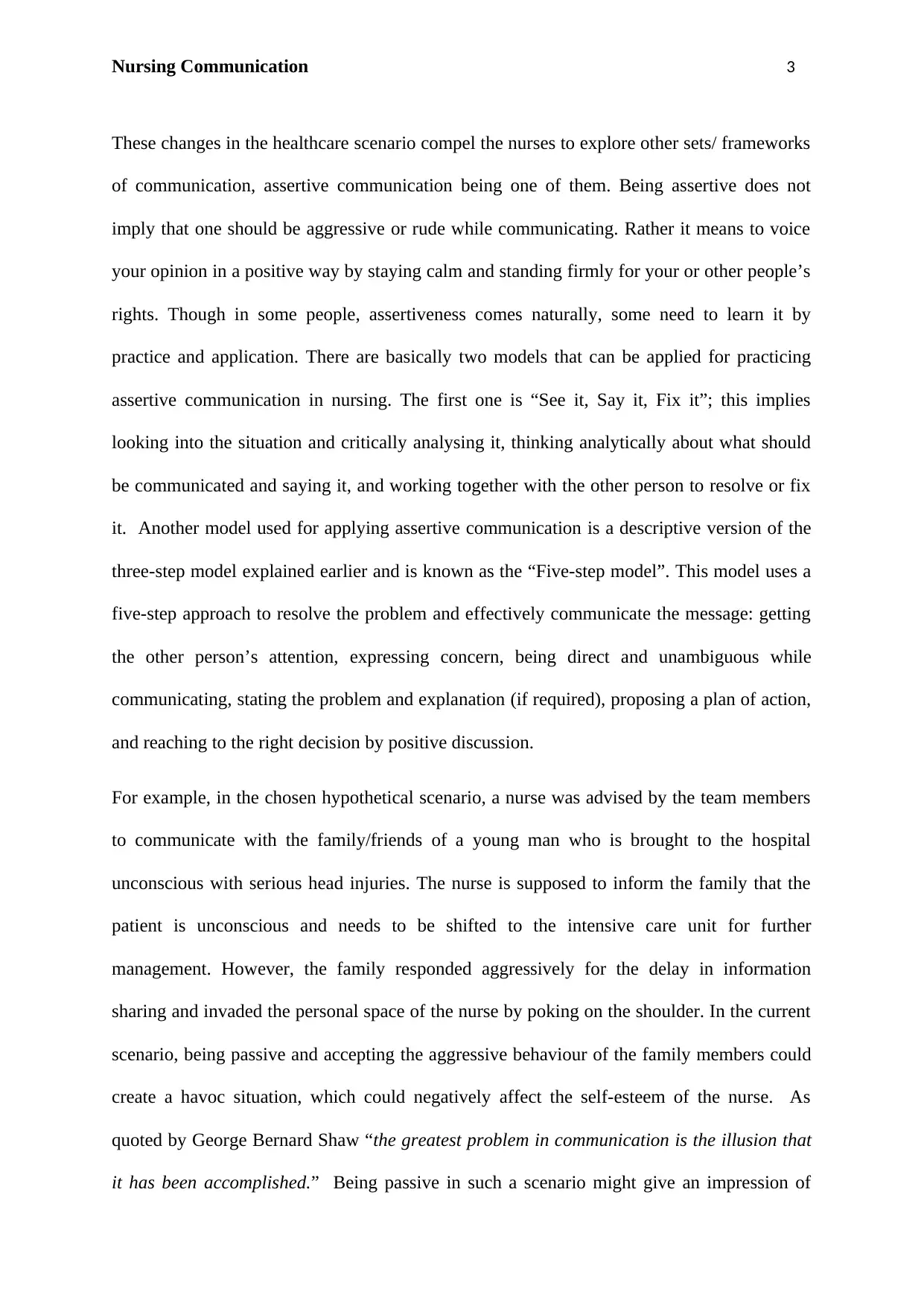
Nursing Communication 3
These changes in the healthcare scenario compel the nurses to explore other sets/ frameworks
of communication, assertive communication being one of them. Being assertive does not
imply that one should be aggressive or rude while communicating. Rather it means to voice
your opinion in a positive way by staying calm and standing firmly for your or other people’s
rights. Though in some people, assertiveness comes naturally, some need to learn it by
practice and application. There are basically two models that can be applied for practicing
assertive communication in nursing. The first one is “See it, Say it, Fix it”; this implies
looking into the situation and critically analysing it, thinking analytically about what should
be communicated and saying it, and working together with the other person to resolve or fix
it. Another model used for applying assertive communication is a descriptive version of the
three-step model explained earlier and is known as the “Five-step model”. This model uses a
five-step approach to resolve the problem and effectively communicate the message: getting
the other person’s attention, expressing concern, being direct and unambiguous while
communicating, stating the problem and explanation (if required), proposing a plan of action,
and reaching to the right decision by positive discussion.
For example, in the chosen hypothetical scenario, a nurse was advised by the team members
to communicate with the family/friends of a young man who is brought to the hospital
unconscious with serious head injuries. The nurse is supposed to inform the family that the
patient is unconscious and needs to be shifted to the intensive care unit for further
management. However, the family responded aggressively for the delay in information
sharing and invaded the personal space of the nurse by poking on the shoulder. In the current
scenario, being passive and accepting the aggressive behaviour of the family members could
create a havoc situation, which could negatively affect the self-esteem of the nurse. As
quoted by George Bernard Shaw “the greatest problem in communication is the illusion that
it has been accomplished.” Being passive in such a scenario might give an impression of
These changes in the healthcare scenario compel the nurses to explore other sets/ frameworks
of communication, assertive communication being one of them. Being assertive does not
imply that one should be aggressive or rude while communicating. Rather it means to voice
your opinion in a positive way by staying calm and standing firmly for your or other people’s
rights. Though in some people, assertiveness comes naturally, some need to learn it by
practice and application. There are basically two models that can be applied for practicing
assertive communication in nursing. The first one is “See it, Say it, Fix it”; this implies
looking into the situation and critically analysing it, thinking analytically about what should
be communicated and saying it, and working together with the other person to resolve or fix
it. Another model used for applying assertive communication is a descriptive version of the
three-step model explained earlier and is known as the “Five-step model”. This model uses a
five-step approach to resolve the problem and effectively communicate the message: getting
the other person’s attention, expressing concern, being direct and unambiguous while
communicating, stating the problem and explanation (if required), proposing a plan of action,
and reaching to the right decision by positive discussion.
For example, in the chosen hypothetical scenario, a nurse was advised by the team members
to communicate with the family/friends of a young man who is brought to the hospital
unconscious with serious head injuries. The nurse is supposed to inform the family that the
patient is unconscious and needs to be shifted to the intensive care unit for further
management. However, the family responded aggressively for the delay in information
sharing and invaded the personal space of the nurse by poking on the shoulder. In the current
scenario, being passive and accepting the aggressive behaviour of the family members could
create a havoc situation, which could negatively affect the self-esteem of the nurse. As
quoted by George Bernard Shaw “the greatest problem in communication is the illusion that
it has been accomplished.” Being passive in such a scenario might give an impression of
⊘ This is a preview!⊘
Do you want full access?
Subscribe today to unlock all pages.

Trusted by 1+ million students worldwide
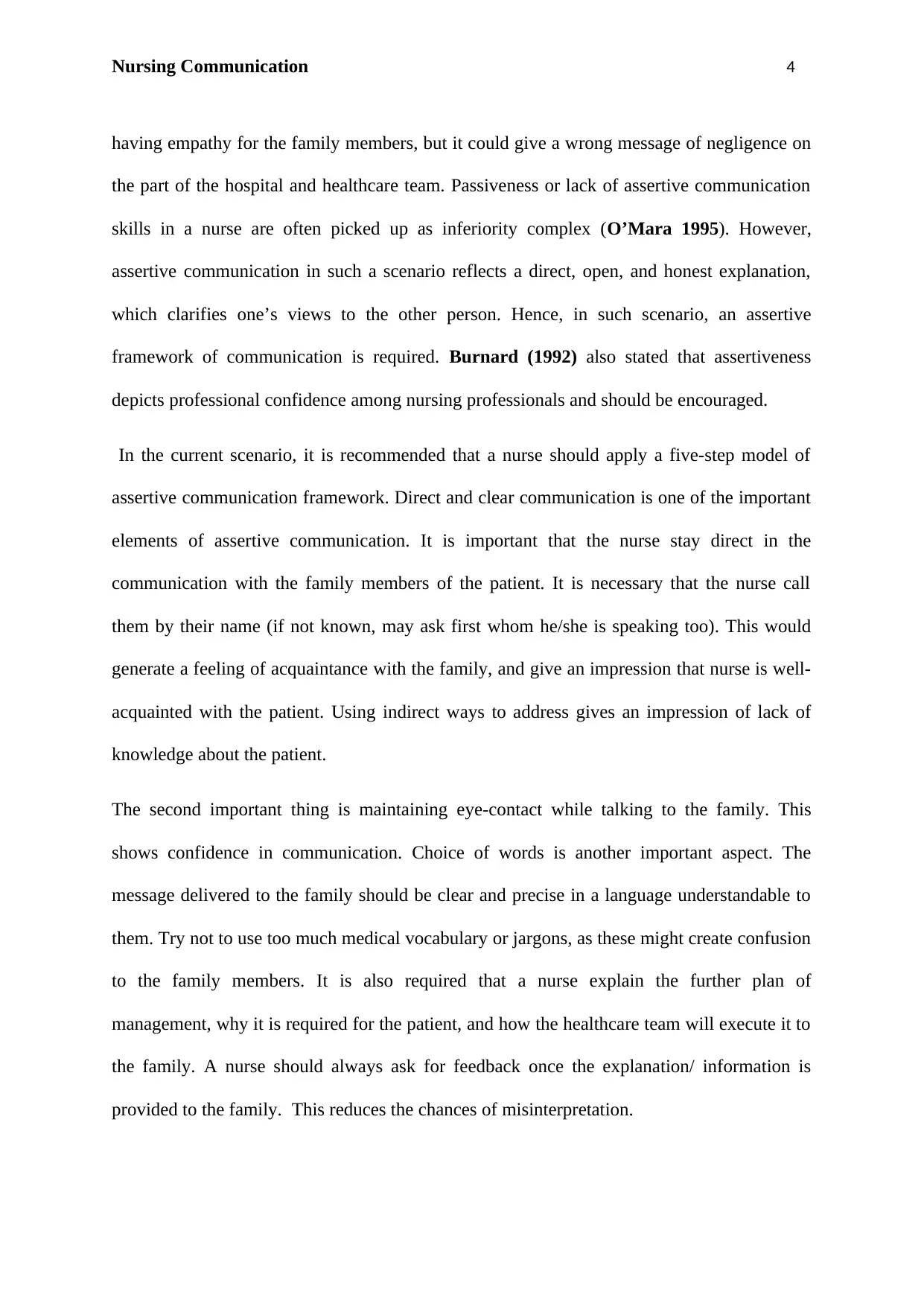
Nursing Communication 4
having empathy for the family members, but it could give a wrong message of negligence on
the part of the hospital and healthcare team. Passiveness or lack of assertive communication
skills in a nurse are often picked up as inferiority complex (O’Mara 1995). However,
assertive communication in such a scenario reflects a direct, open, and honest explanation,
which clarifies one’s views to the other person. Hence, in such scenario, an assertive
framework of communication is required. Burnard (1992) also stated that assertiveness
depicts professional confidence among nursing professionals and should be encouraged.
In the current scenario, it is recommended that a nurse should apply a five-step model of
assertive communication framework. Direct and clear communication is one of the important
elements of assertive communication. It is important that the nurse stay direct in the
communication with the family members of the patient. It is necessary that the nurse call
them by their name (if not known, may ask first whom he/she is speaking too). This would
generate a feeling of acquaintance with the family, and give an impression that nurse is well-
acquainted with the patient. Using indirect ways to address gives an impression of lack of
knowledge about the patient.
The second important thing is maintaining eye-contact while talking to the family. This
shows confidence in communication. Choice of words is another important aspect. The
message delivered to the family should be clear and precise in a language understandable to
them. Try not to use too much medical vocabulary or jargons, as these might create confusion
to the family members. It is also required that a nurse explain the further plan of
management, why it is required for the patient, and how the healthcare team will execute it to
the family. A nurse should always ask for feedback once the explanation/ information is
provided to the family. This reduces the chances of misinterpretation.
having empathy for the family members, but it could give a wrong message of negligence on
the part of the hospital and healthcare team. Passiveness or lack of assertive communication
skills in a nurse are often picked up as inferiority complex (O’Mara 1995). However,
assertive communication in such a scenario reflects a direct, open, and honest explanation,
which clarifies one’s views to the other person. Hence, in such scenario, an assertive
framework of communication is required. Burnard (1992) also stated that assertiveness
depicts professional confidence among nursing professionals and should be encouraged.
In the current scenario, it is recommended that a nurse should apply a five-step model of
assertive communication framework. Direct and clear communication is one of the important
elements of assertive communication. It is important that the nurse stay direct in the
communication with the family members of the patient. It is necessary that the nurse call
them by their name (if not known, may ask first whom he/she is speaking too). This would
generate a feeling of acquaintance with the family, and give an impression that nurse is well-
acquainted with the patient. Using indirect ways to address gives an impression of lack of
knowledge about the patient.
The second important thing is maintaining eye-contact while talking to the family. This
shows confidence in communication. Choice of words is another important aspect. The
message delivered to the family should be clear and precise in a language understandable to
them. Try not to use too much medical vocabulary or jargons, as these might create confusion
to the family members. It is also required that a nurse explain the further plan of
management, why it is required for the patient, and how the healthcare team will execute it to
the family. A nurse should always ask for feedback once the explanation/ information is
provided to the family. This reduces the chances of misinterpretation.
Paraphrase This Document
Need a fresh take? Get an instant paraphrase of this document with our AI Paraphraser
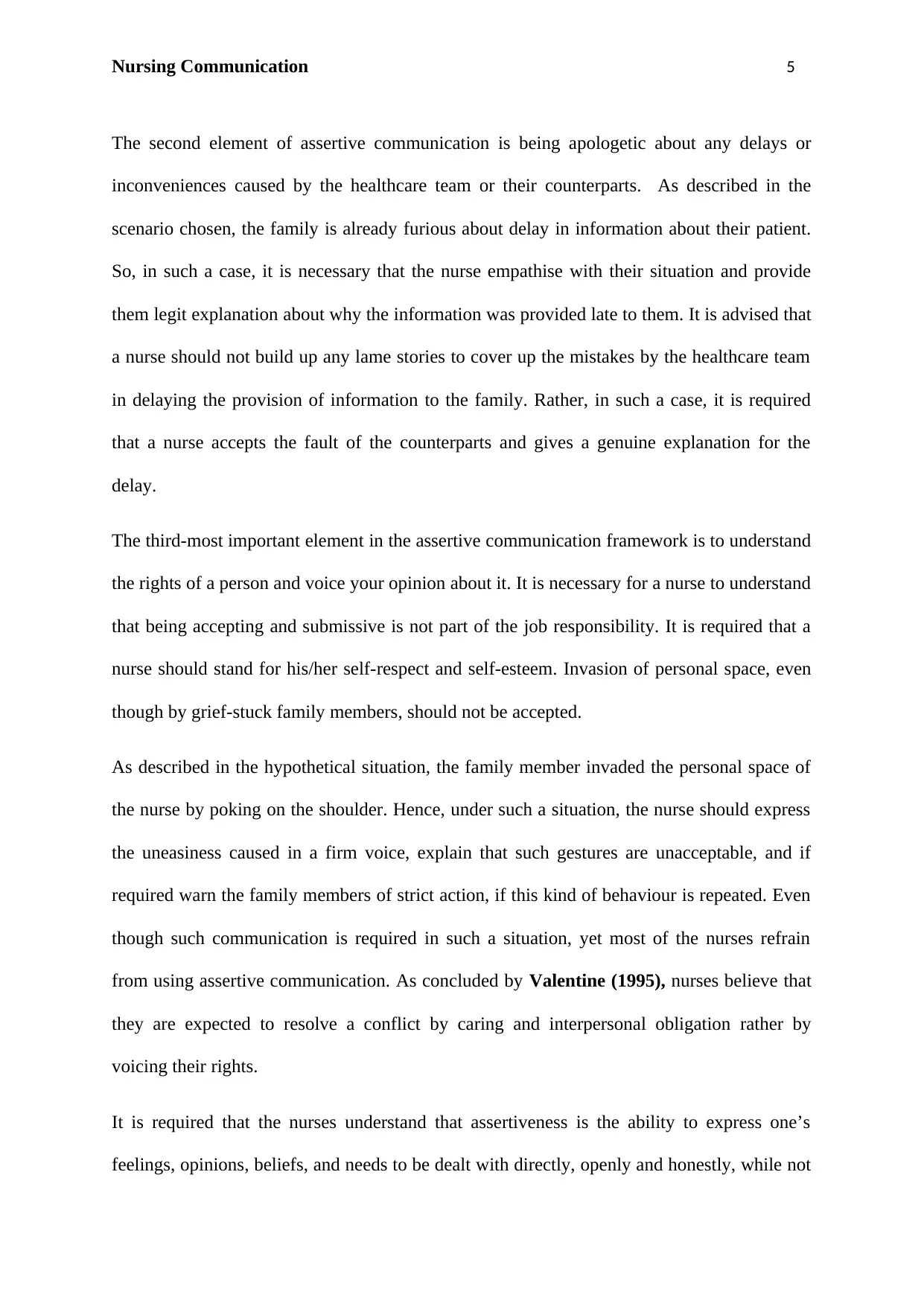
Nursing Communication 5
The second element of assertive communication is being apologetic about any delays or
inconveniences caused by the healthcare team or their counterparts. As described in the
scenario chosen, the family is already furious about delay in information about their patient.
So, in such a case, it is necessary that the nurse empathise with their situation and provide
them legit explanation about why the information was provided late to them. It is advised that
a nurse should not build up any lame stories to cover up the mistakes by the healthcare team
in delaying the provision of information to the family. Rather, in such a case, it is required
that a nurse accepts the fault of the counterparts and gives a genuine explanation for the
delay.
The third-most important element in the assertive communication framework is to understand
the rights of a person and voice your opinion about it. It is necessary for a nurse to understand
that being accepting and submissive is not part of the job responsibility. It is required that a
nurse should stand for his/her self-respect and self-esteem. Invasion of personal space, even
though by grief-stuck family members, should not be accepted.
As described in the hypothetical situation, the family member invaded the personal space of
the nurse by poking on the shoulder. Hence, under such a situation, the nurse should express
the uneasiness caused in a firm voice, explain that such gestures are unacceptable, and if
required warn the family members of strict action, if this kind of behaviour is repeated. Even
though such communication is required in such a situation, yet most of the nurses refrain
from using assertive communication. As concluded by Valentine (1995), nurses believe that
they are expected to resolve a conflict by caring and interpersonal obligation rather by
voicing their rights.
It is required that the nurses understand that assertiveness is the ability to express one’s
feelings, opinions, beliefs, and needs to be dealt with directly, openly and honestly, while not
The second element of assertive communication is being apologetic about any delays or
inconveniences caused by the healthcare team or their counterparts. As described in the
scenario chosen, the family is already furious about delay in information about their patient.
So, in such a case, it is necessary that the nurse empathise with their situation and provide
them legit explanation about why the information was provided late to them. It is advised that
a nurse should not build up any lame stories to cover up the mistakes by the healthcare team
in delaying the provision of information to the family. Rather, in such a case, it is required
that a nurse accepts the fault of the counterparts and gives a genuine explanation for the
delay.
The third-most important element in the assertive communication framework is to understand
the rights of a person and voice your opinion about it. It is necessary for a nurse to understand
that being accepting and submissive is not part of the job responsibility. It is required that a
nurse should stand for his/her self-respect and self-esteem. Invasion of personal space, even
though by grief-stuck family members, should not be accepted.
As described in the hypothetical situation, the family member invaded the personal space of
the nurse by poking on the shoulder. Hence, under such a situation, the nurse should express
the uneasiness caused in a firm voice, explain that such gestures are unacceptable, and if
required warn the family members of strict action, if this kind of behaviour is repeated. Even
though such communication is required in such a situation, yet most of the nurses refrain
from using assertive communication. As concluded by Valentine (1995), nurses believe that
they are expected to resolve a conflict by caring and interpersonal obligation rather by
voicing their rights.
It is required that the nurses understand that assertiveness is the ability to express one’s
feelings, opinions, beliefs, and needs to be dealt with directly, openly and honestly, while not
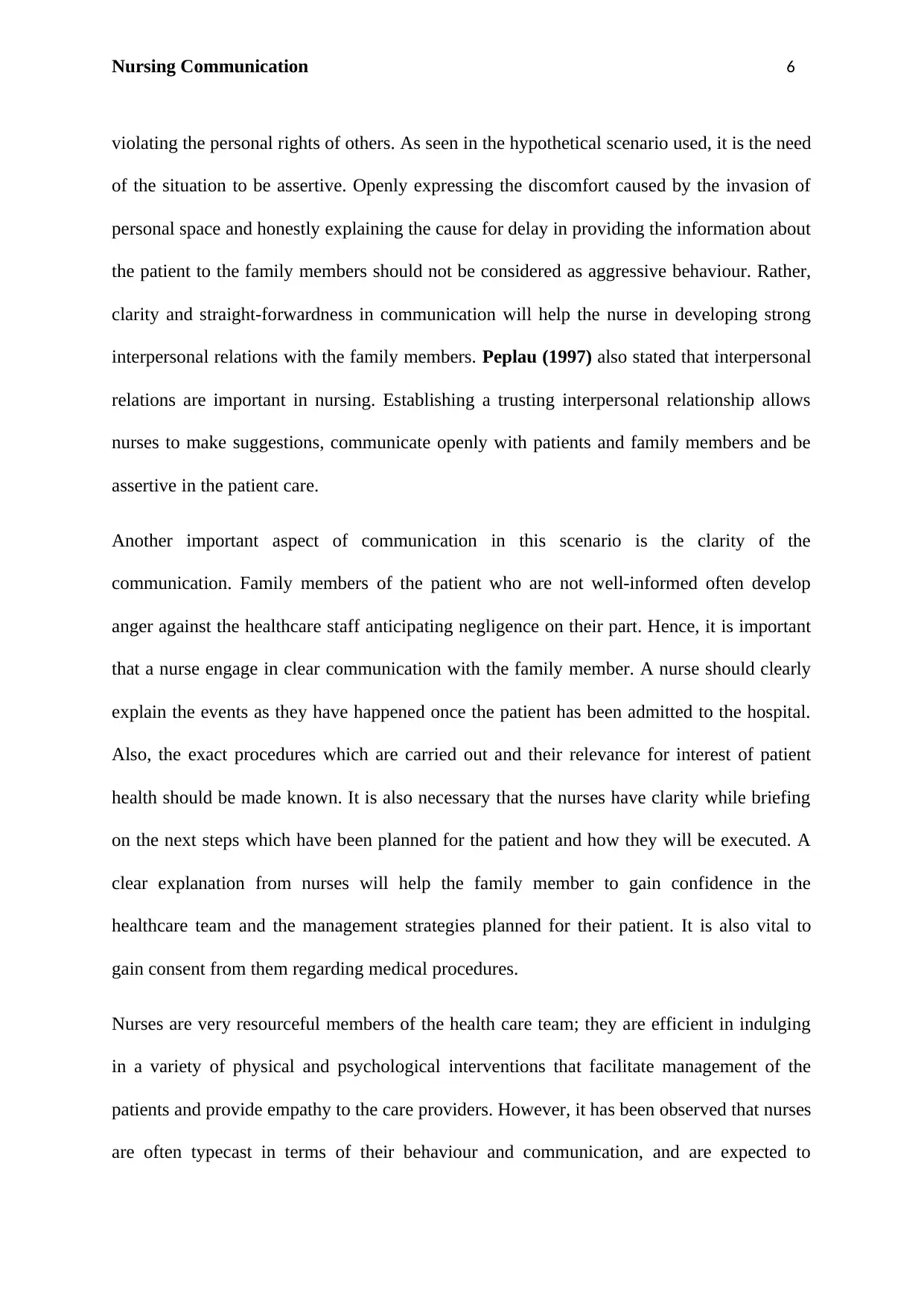
Nursing Communication 6
violating the personal rights of others. As seen in the hypothetical scenario used, it is the need
of the situation to be assertive. Openly expressing the discomfort caused by the invasion of
personal space and honestly explaining the cause for delay in providing the information about
the patient to the family members should not be considered as aggressive behaviour. Rather,
clarity and straight-forwardness in communication will help the nurse in developing strong
interpersonal relations with the family members. Peplau (1997) also stated that interpersonal
relations are important in nursing. Establishing a trusting interpersonal relationship allows
nurses to make suggestions, communicate openly with patients and family members and be
assertive in the patient care.
Another important aspect of communication in this scenario is the clarity of the
communication. Family members of the patient who are not well-informed often develop
anger against the healthcare staff anticipating negligence on their part. Hence, it is important
that a nurse engage in clear communication with the family member. A nurse should clearly
explain the events as they have happened once the patient has been admitted to the hospital.
Also, the exact procedures which are carried out and their relevance for interest of patient
health should be made known. It is also necessary that the nurses have clarity while briefing
on the next steps which have been planned for the patient and how they will be executed. A
clear explanation from nurses will help the family member to gain confidence in the
healthcare team and the management strategies planned for their patient. It is also vital to
gain consent from them regarding medical procedures.
Nurses are very resourceful members of the health care team; they are efficient in indulging
in a variety of physical and psychological interventions that facilitate management of the
patients and provide empathy to the care providers. However, it has been observed that nurses
are often typecast in terms of their behaviour and communication, and are expected to
violating the personal rights of others. As seen in the hypothetical scenario used, it is the need
of the situation to be assertive. Openly expressing the discomfort caused by the invasion of
personal space and honestly explaining the cause for delay in providing the information about
the patient to the family members should not be considered as aggressive behaviour. Rather,
clarity and straight-forwardness in communication will help the nurse in developing strong
interpersonal relations with the family members. Peplau (1997) also stated that interpersonal
relations are important in nursing. Establishing a trusting interpersonal relationship allows
nurses to make suggestions, communicate openly with patients and family members and be
assertive in the patient care.
Another important aspect of communication in this scenario is the clarity of the
communication. Family members of the patient who are not well-informed often develop
anger against the healthcare staff anticipating negligence on their part. Hence, it is important
that a nurse engage in clear communication with the family member. A nurse should clearly
explain the events as they have happened once the patient has been admitted to the hospital.
Also, the exact procedures which are carried out and their relevance for interest of patient
health should be made known. It is also necessary that the nurses have clarity while briefing
on the next steps which have been planned for the patient and how they will be executed. A
clear explanation from nurses will help the family member to gain confidence in the
healthcare team and the management strategies planned for their patient. It is also vital to
gain consent from them regarding medical procedures.
Nurses are very resourceful members of the health care team; they are efficient in indulging
in a variety of physical and psychological interventions that facilitate management of the
patients and provide empathy to the care providers. However, it has been observed that nurses
are often typecast in terms of their behaviour and communication, and are expected to
⊘ This is a preview!⊘
Do you want full access?
Subscribe today to unlock all pages.

Trusted by 1+ million students worldwide
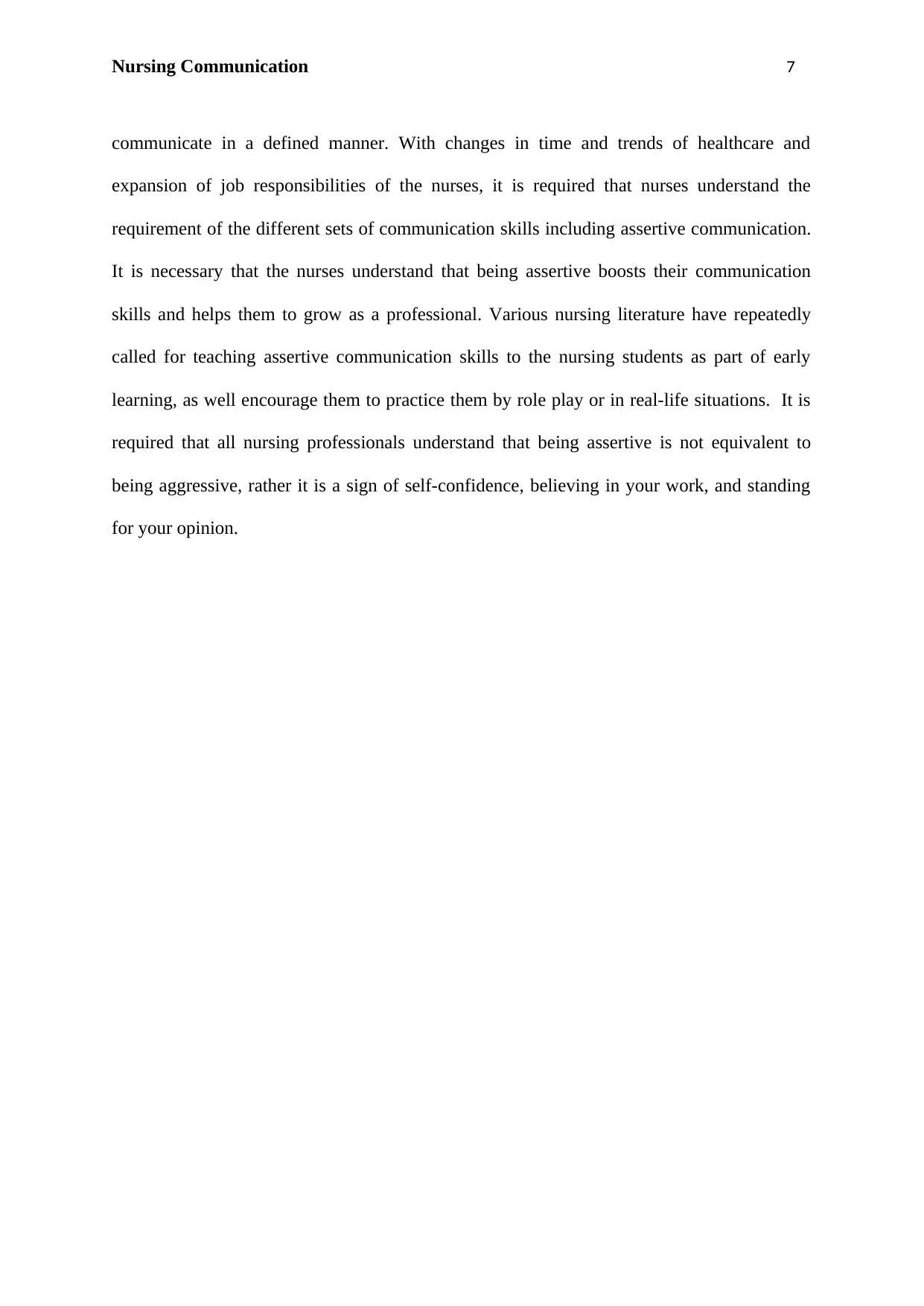
Nursing Communication 7
communicate in a defined manner. With changes in time and trends of healthcare and
expansion of job responsibilities of the nurses, it is required that nurses understand the
requirement of the different sets of communication skills including assertive communication.
It is necessary that the nurses understand that being assertive boosts their communication
skills and helps them to grow as a professional. Various nursing literature have repeatedly
called for teaching assertive communication skills to the nursing students as part of early
learning, as well encourage them to practice them by role play or in real-life situations. It is
required that all nursing professionals understand that being assertive is not equivalent to
being aggressive, rather it is a sign of self-confidence, believing in your work, and standing
for your opinion.
communicate in a defined manner. With changes in time and trends of healthcare and
expansion of job responsibilities of the nurses, it is required that nurses understand the
requirement of the different sets of communication skills including assertive communication.
It is necessary that the nurses understand that being assertive boosts their communication
skills and helps them to grow as a professional. Various nursing literature have repeatedly
called for teaching assertive communication skills to the nursing students as part of early
learning, as well encourage them to practice them by role play or in real-life situations. It is
required that all nursing professionals understand that being assertive is not equivalent to
being aggressive, rather it is a sign of self-confidence, believing in your work, and standing
for your opinion.
Paraphrase This Document
Need a fresh take? Get an instant paraphrase of this document with our AI Paraphraser
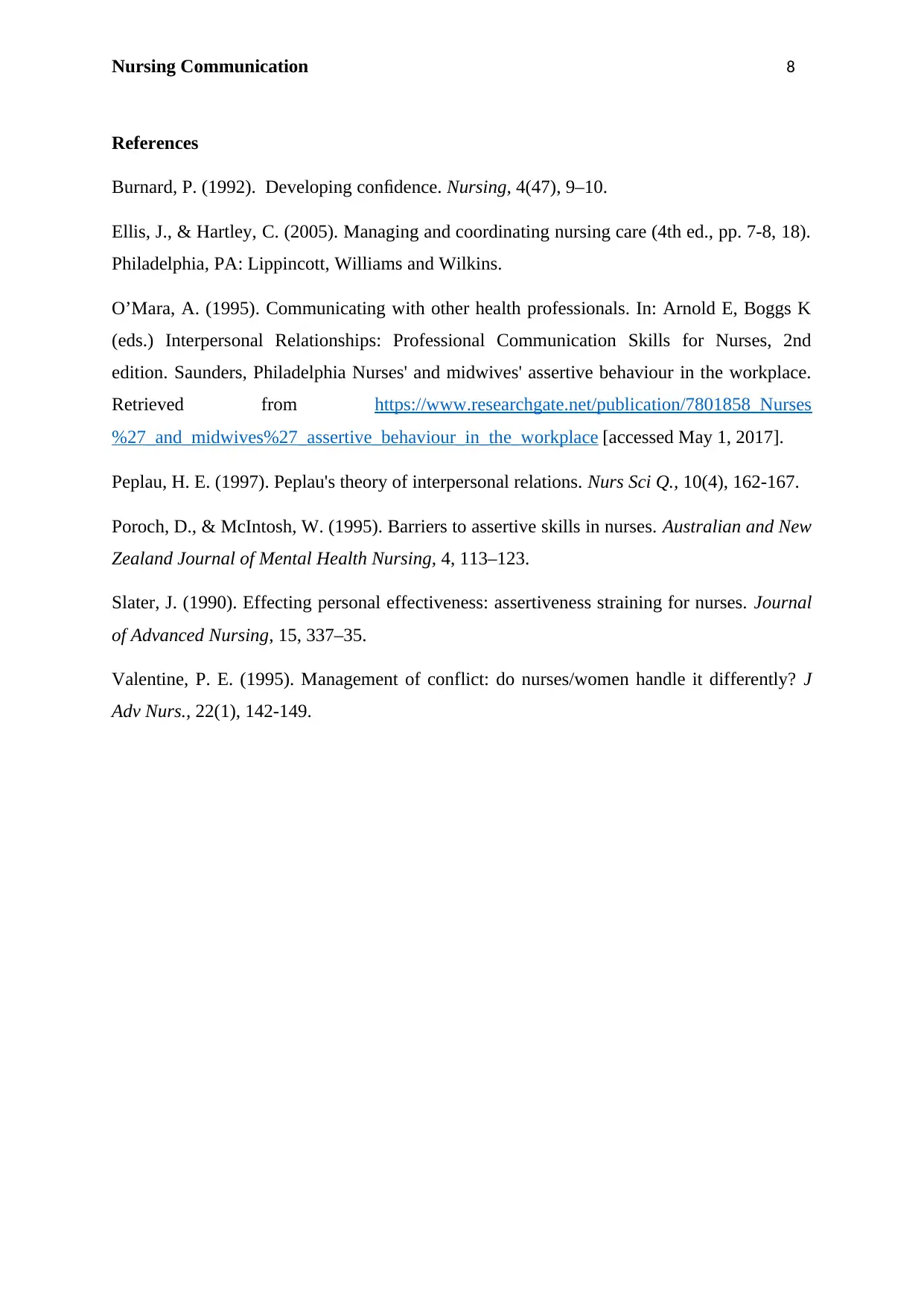
Nursing Communication 8
References
Burnard, P. (1992). Developing confidence. Nursing, 4(47), 9–10.
Ellis, J., & Hartley, C. (2005). Managing and coordinating nursing care (4th ed., pp. 7-8, 18).
Philadelphia, PA: Lippincott, Williams and Wilkins.
O’Mara, A. (1995). Communicating with other health professionals. In: Arnold E, Boggs K
(eds.) Interpersonal Relationships: Professional Communication Skills for Nurses, 2nd
edition. Saunders, Philadelphia Nurses' and midwives' assertive behaviour in the workplace.
Retrieved from https://www.researchgate.net/publication/7801858_Nurses
%27_and_midwives%27_assertive_behaviour_in_the_workplace [accessed May 1, 2017].
Peplau, H. E. (1997). Peplau's theory of interpersonal relations. Nurs Sci Q., 10(4), 162-167.
Poroch, D., & McIntosh, W. (1995). Barriers to assertive skills in nurses. Australian and New
Zealand Journal of Mental Health Nursing, 4, 113–123.
Slater, J. (1990). Effecting personal effectiveness: assertiveness straining for nurses. Journal
of Advanced Nursing, 15, 337–35.
Valentine, P. E. (1995). Management of conflict: do nurses/women handle it differently? J
Adv Nurs., 22(1), 142-149.
References
Burnard, P. (1992). Developing confidence. Nursing, 4(47), 9–10.
Ellis, J., & Hartley, C. (2005). Managing and coordinating nursing care (4th ed., pp. 7-8, 18).
Philadelphia, PA: Lippincott, Williams and Wilkins.
O’Mara, A. (1995). Communicating with other health professionals. In: Arnold E, Boggs K
(eds.) Interpersonal Relationships: Professional Communication Skills for Nurses, 2nd
edition. Saunders, Philadelphia Nurses' and midwives' assertive behaviour in the workplace.
Retrieved from https://www.researchgate.net/publication/7801858_Nurses
%27_and_midwives%27_assertive_behaviour_in_the_workplace [accessed May 1, 2017].
Peplau, H. E. (1997). Peplau's theory of interpersonal relations. Nurs Sci Q., 10(4), 162-167.
Poroch, D., & McIntosh, W. (1995). Barriers to assertive skills in nurses. Australian and New
Zealand Journal of Mental Health Nursing, 4, 113–123.
Slater, J. (1990). Effecting personal effectiveness: assertiveness straining for nurses. Journal
of Advanced Nursing, 15, 337–35.
Valentine, P. E. (1995). Management of conflict: do nurses/women handle it differently? J
Adv Nurs., 22(1), 142-149.
1 out of 8
Related Documents
Your All-in-One AI-Powered Toolkit for Academic Success.
+13062052269
info@desklib.com
Available 24*7 on WhatsApp / Email
![[object Object]](/_next/static/media/star-bottom.7253800d.svg)
Unlock your academic potential
Copyright © 2020–2025 A2Z Services. All Rights Reserved. Developed and managed by ZUCOL.





